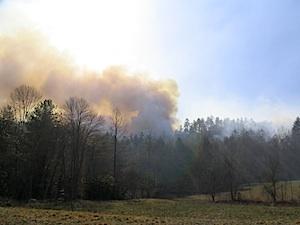Smoky conditions likely will be found around Cataloochee in Great Smoky Mountains National Park over the next few weeks as park crews work on burning through 400 acres of landscape.
The prescribed burns, in the Canadian Top unit adjacent to Cataloochee Valley in North Carolina, could begin as soon as Monday, weather permitting, and continue off and on through early November.
The two burn units are located on Bald Top adjacent to Mathews Branch near the Cataloochee Ranger Station. The units are part of the larger Canadian Top multi-year prescribed fire project, where fire managers have been conducting a series of low-intensity, controlled burns to restore the composition and open structure of the oak woodlands that occur on upper slopes and ridges within the site. These fire and drought-tolerant natural communities are important to wildlife and overall ecosystem health which are in decline throughout the Southern Appalachian region.
"One of the goals of the prescribed burn is to improve elk forage and habitat," said Shane Paxton, who leads the park's Wildland Fire Module. “This series of burns will reduce the number of fire-sensitive trees and shrubs while increasing the regeneration of oak and yellow pines along with increasing the cover and diversity of native grasses and wildflowers. Over time, this increase in herbaceous vegetation on the forest floor will improve forage for elk which graze the nearby meadows.”
Roads and trails will remain open to the public throughout the burn operations, although Little Cataloochee Trail may be temporarily closed if fire activity warrants. Visitors should expect to see smoke in the area.
The burn operations will be conducted by park staff and are being funded by the Rocky Mountain Elk Foundation.




Comments
"PC run amuck"?
I thought you were one of the ones faulting NPS for insufficient transparency. It appears that simple "just tell us the truth up front" is what was asked for here.
dahkota, tnhiker and others who are suspicious of the RMEF.... go to their website and read their mission statement, goals and objectives. They have a long history of the conservation and re-introduction of elk on historic ranges. Look additionally at the numbers of acres they have purchased on the open market and transferred to States and the Feds for conservation purposes.... they're big players in the conservation of wildlife, because every acre conserved for elk benefits a myriad of other species and not just game species.
Yes, they want to hunt elk... so do I. Americans have always hunted elk and I hope they always do. They are a great conservation organization actually putting the dollars generated by their members to conservation in direct support of elk (and all other species).
And what proof do you have they aren't telling the truth up front - not that it makes any difference if the end result is positive for the elk. As usual I don't expect a response as I am sure you are engaged in your typical hit and run tactics.
It wasn't my question, gadfly. I was commenting on someone else's question. You, I try to just ignore.
You quote me but are just commenting on someone else's post??? I guess I was right, back to your hit and run.
For me, as with many others, true motivation is always important as is true intent. As a matter of fact, many laws in our country are based on intent, rather than outcome.
As I pointed out in my original post, I think, in this case, if there is ulterior motive, hidden agenda, covert reasons, etc. and whatever else you want to call it, the good outweighs the bad. However, I will alway hold that covert agendas are rarely good because, if you have to hide your true intent, maybe it isn't morally just in the first place.
I am not going to argue here with you, ec, because you have nothing to add to the conversation and there is nothing here about which to argue. You have made no point and you will continue to not read what is previously posted, instead picking out bits and pieces with which you can disagree.
MikeG - You make some valid points. As I posted originally, since I do not know their motivations, I am not going to guess at them. However, something having been done in the past has no relation to the how or why it is done in the present or in the future. I'm not stating anything related to RMEF in that, just that your argument that hunting "has been done in the past" is a fallacious argument.
My point is that noone has made a case for a "hidden agenda", and if the ultimate outcome is good - who cares.
It's too bad the red wolf reintroduction wasn't successful at GSMNP. Assuming that red wolves prey on elk (although I don't know if they do), the reintroduction might have presenting an interesting ecology, especially if elk management becomes an issue inside the park.